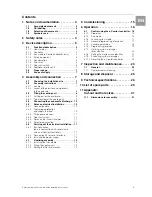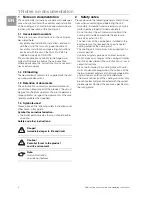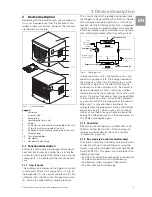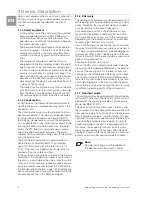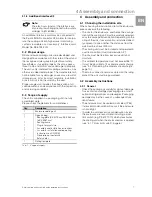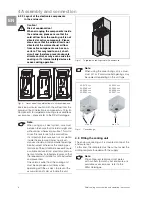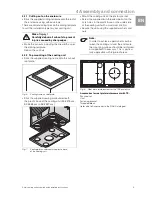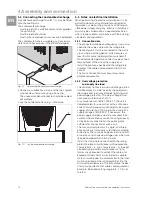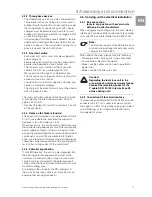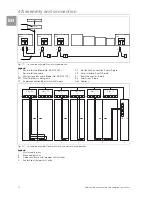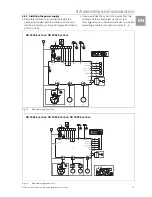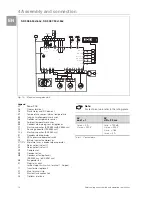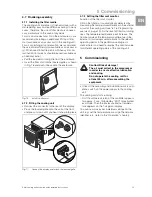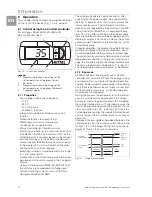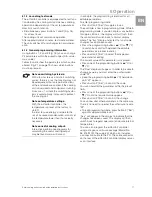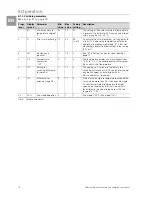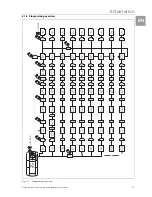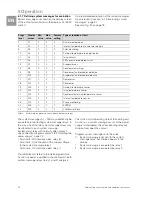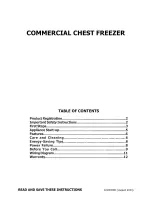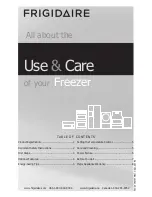
3 Device description
Rittal cooling unit assembly and operating instructions
5
EN
3
Device description
Depending on the model chosen, your cooling unit
may vary in appearance from the illustrations con-
tained in these instructions. However, the functions
are identical in principle.
Fig. 1:
Unit description
Legend
1
Enclosure
2
Air outlet holes
3
Rating plate
4
Louvred grille for air inlet
5
Display
6
X2 master-slave connection (underside of the unit)
7
X1 terminal strip (underside of the unit)
8
X3 optional serial interface (underside of the unit)
9
Dispatch bag
10
Twin-threaded bolt
11
Condenser
12
Condensate discharge
3.1 Functional description
Enclosure cooling units are designed to dissipate
heat from enclosures by cooling the air inside the
enclosure and so protect the temperature-sensitive
components. It is mounted on the roof of an enclo-
sure.
3.1.1 How it works
The cooling unit (compression refrigeration system)
is comprised of four main components (cf. Fig. 2):
the evaporator (1), the coolant compressor (2), the
condenser (3), and the control or expansion valve
(4), which are connected by suitable pipework.
This circuit is filled with a readily boiling substance,
the refrigerant. Coolant R134a (CH
2
FCF
3
) is chlorine-
free. Its ozone destruction potential is 0, making it
very eco-friendly. A filter dryer (5) which is integrated
into the hermetically sealed cooling circuit provides
effective protection against moisture, acid, dirt parti-
cles, and foreign bodies within the cooling circuit.
Fig. 2:
Cooling circuit
In the evaporator coil (1), the liquid coolant is con-
verted to a gaseous state. The energy needed for
this purpose is taken from the enclosure air in the
form of heat, which has the effect of cooling the
enclosure air. In the compressor (2), the coolant is
heavily compressed, so that it achieves a higher
temperature inside the condenser (3) than the ambi-
ent air. This means that excess heat may be emitted
to the ambient air via the surface of the condenser,
as a result of which the temperature of the coolant
drops and it is converted back into liquid. It is
re-injected into the evaporator coil via a thermostatic
expansion valve (4), which causes it to cool down
further, and is then once again able to absorb the
energy from the enclosure air in the evaporator coil.
The whole cycle begins again.
3.1.2 Controller
Rittal enclosure cooling units are fitted with a con-
troller for setting the functions of the cooling unit
(display plus extended functions, see chapter
“6 Operation”, page 16).
3.1.3 Bus mode (e-Comfort controller only)
The serial unit interface X2 allows you to create a bus
connection with up to ten cooling units using the
master-slave cable (shielded, four-wire cable, Model
No. SK 3124.100). This allows you to implement the
following functions:
– Parallel unit control (the cooling units in the network
can be switched on and off simultaneously)
– Parallel door status message (“door open”)
– Parallel collective fault message
3
6, 7, 8
12
4
11
10
9
5
2
1
PSA
H
pressure-
operated
switch
Condenser fan
Expansion valve (4)
Temperature
control
Filter dryer (5)
Internal circuit
Compressor
(2)
External circuit
Evaporator fan
Evaporator coil (1)
Condenser (3)
Summary of Contents for SK 3273.xxx
Page 2: ......



